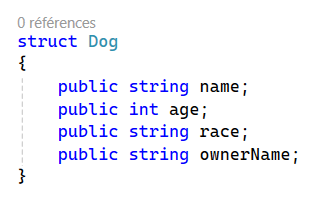Object representation in Scratch
scratchtomv
In Scratch, the basic way of storing data is by using variables, which can contain one information at a time. But how to store multiple pieces of information related to one object?
Let’s take the example of a dog : we need dog objects with multiple information related to it, like his name, his age, his race, his owner, etc.
Would look like this in C# :

It can also be represented as a table :
| Data index | Property name |
|---|---|
| 1 | Name (string) |
| 2 | Age (int) |
| 3 | Race (string) |
| 4 | Owner Name (string) |
This object needs 4 data slots to be stored.
Storing objects in lists
scratchtomv
We just saw how to create one object, but what about handling thousands of theses ? Meshes can contain thousands of faces and vertices, we can’t hold all this data in a few variables, we need to use lists.
Lists in scratch are indexed by an integer starting from 1 (unlike most programming languages which start from zero), and each item in a list can hold values of any type Scratch variables can.
To store objects in a list, we need to partition it. There are multiple ways of partitioning a list, which we’ll see in the next parts.
Constant and defined object size
scratchtomv
If the objects stored in the list always take an n-amount of data slots, the list can be divided into groups of n-slots. It’s the most efficient and the most common way of storing objects.
| Index | Data | Object representation |
|---|---|---|
| 1 | Property A | Object 1 |
| 2 | Property B | |
| 3 | Property A | Object 2 |
| 4 | Property B | |
| 5 | Property A | Object 3 |
| 6 | Property B |
This simple scratch function create a dog (works for any kind of objects) :
define Add dog (name) (age) (race) (owner)
add (name) to [my dogs v]
add (age) to [my dogs v]
add (race) to [my dogs v]
add (owner) to [my dogs v]
…And is used like that

The object data can be accessed with two methods :
This is the fastest way, but you need to increment the dog index by 4 when looping through the list of dogs :
(item ((put your dog index here) + (put your data index here)) of [my dogs v])
This way is a bit slower and uses one more block, but is more straightforward :
(item (((put your dog index here) * (4)) + (put your data index here)) of [my dogs v])
This example accesses the age of the dog #0, and returns the second item for this dog, in this case 4 :
(item ((0) + (2)) of [my dogs v])
Constant but undefined object size using a list of pointers
scratchtomv
If the objects stored in the list can take any amount of data slots, the list can’t be divided into groups of constant n-slots. Thus, to be able to access its data correctly we need the use of another list containing pointers to the list containing the objects. This concept is used in a variety of situations.
| Index | Data | Object representation |
|---|---|---|
| 1 | Property A | Object 1 |
| 2 | Property B | |
| 3 | Property C | |
| 4 | Property A | Object 2 |
| 5 | Property A | Object 3 |
| 6 | Property B |
| Index | Data |
|---|---|
| 1 | 1 => (Pointer to object 1) |
| 2 | 4 => (Pointer to object 2) |
| 3 | 5 => (Pointer to object 3) |
Dynamic object size
scratchtomv
Dynamic object allocating is really slow and you should avoid it by using other storing methods, such as pre-allocating enough data slots.
But if you really need to be able to grow or shrink an object size, you can achieve it by using linked lists :
- When an object A needs to grow in size, use the “insert” block to insert a new data slot, then loop through all the pointer’s list and increase by 1 all pointers higher than the object A index.1
- When an object B needs to shrink in size, do the same as the growing operation but with the “remove at” block to remove the desired data slot, and decrease by 1 the pointers.